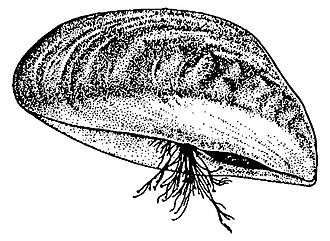Difference between revisions of "AY Honors/Shells - Advanced/Answer Key"
m (45 revisions from w:Byssus) |
m (Transwiki:Byssus moved to AY Honor Shells - Advanced: transwiki merge) |
Revision as of 01:24, 7 August 2008
Byssus, plural "byssi", derives from Hebrew būṣ 'fine linen,' Aramaic bus, Greek βύσσος – 'a very fine yellowish flax and the linen woven from it', Latin byssus – 'fine cotton or cotton stuff', 'silk' and via New Latin to 'sea silk'.
As may be seen above, the word byssus not only refers to the excretions of seashells, as sometimes assumed, but was originally used for various fine threads and cloths. The word is used twice in the text of the Rosetta Stone.
- An exceptionally fine and valuable fibre or cloth of ancient times. Originally used for fine flax and linens, its use was later extended to fine cottons, silks, and sea silk.
- The long fine silky filaments excreted by several mollusks (particularly Pinna nobilis) by which they attach themselves to the sea bed, from which sea silk is manufactured. They range to 6 cm in length.
- The stipe (stem) of certain fungi which are particularly thin and thread-like.
In mussels

Mussels use byssus to attach to rocks and other surfaces. When a mussel's foot encounters a crevice, it creates a vacuum chamber by forcing out the air and arching up, similar to a plumber's plunger unclogging a drain. The byssus, made of keratin and other proteins, is spewed into this chamber, and bubbles into a sticky foam. By curling its foot into a tube and pumping the foam, the mussel produces sticky threads about the size of a human hair. It varnishes the threads with another protein, resulting in an adhesive.
Byssus is a remarkable adhesive that is neither degraded nor deformed by water as are synthetic adhesives. This has spurred genetic engineers to insert mussel DNA into yeast cells for translating the genes into the appropriate proteins.
References
- The Compact edition of the Oxford English dictionary: complete text reproduced micrographically and Supplement. Oxford at the Clarendon Press. 1987
- Webster's Third New International Dictionary (Unabridged) 1976. G. & C. Merriam Co.
- Ecsedy, Hilda 1975. "Böz – An Exotic Cloth in the Chinese Imperial Court." Hilda Ecsedy. Altorientalische Forschungen 3: pp. 145-153.
- Starr, Cecie and Taggart, Ralph. Biology: The Unity and Diversity of Life. Belmont, CA: Thomson Learning, Inc., 2004.
de:Byssus es:Biso eo:Bisino fr:Byssus it:Bisso lb:Byssus nl:Byssus pl:Bisior zh:Byssus
